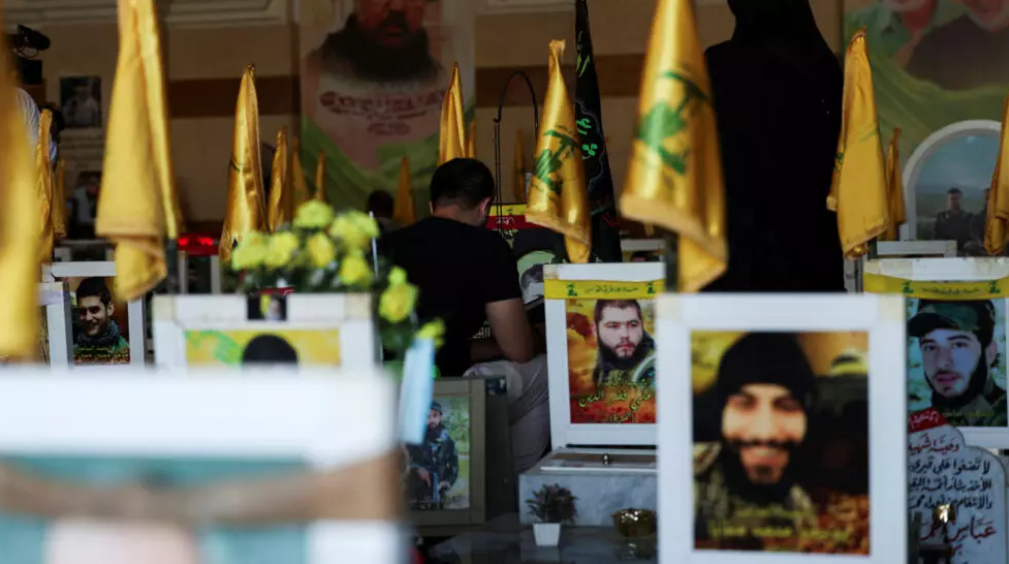
This article is more than
1 year oldWhat the operation to blow up Hezbollah’s pagers tells us about Israel’s spy agencies

The mass explosions of pagers and walkie-talkies believed to belong to members of the Iran-backed Shiite group Hezbollah in Lebanon have widely been attributed to Israel’s intelligence services. The attacks, which killed dozens of people and wounded thousands more, speak volumes about the technical capacities of Israel’s spy services – and their role in the ongoing conflict in the Middle East.
The deadly sabotage operations targeting pagers and walkie-talkies in Lebanon earlier this week have been called many things. But while the attacks have been condemned by many people as “morally questionable” and “legally dubious”, others have hailed them as “technically impressive” and fiendishly “effective”.
Whatever your opinion on the explosions that targeted thousands of people believed to be members of Hezbollah, killing dozens of people – including at least two children – and wounding thousands more, the attacks have placed Israel’s shadowy spy services squarely back in the spotlight.
Making up for the failures of October 7
Mossad and Israeli military intelligence have been badly in need of a win. Aviva Guttmann, a specialist in the history of intelligence services in Europe and the Middle East at the University of Aberystwyth, Wales, said that the failure to anticipate, much less prevent, the deadly October 7, 2023 attacks had cast a long shadow over the agencies.“This attack on Lebanon with the pagers and the walkie-talkies is kind of a way of rehabilitating their reputation,” she said. “It’s a show of strength, essentially.”
But the details of the organisation and execution of Israel’s plan are still fuzzy, and what little information we have is evolving rapidly.
Trying to trace the origin of the booby-trapped pagers has proved complicated. Manufactured in Taiwan, the small devices would then have been assembled by a subsidiary in Hungary, which in turn has been described in the media as a likely front set up by Israeli intelligence several years ago. And Israel’s intelligence services could well have manufactured the pagers themselves – though not necessarily in Hungary.
TECH 24 © FRANCE 24
Israel has not, for its part, claimed responsibility for the operation – though that’s nothing new.
“Israel denies this,” said Daniel Lomas, a specialist in intelligence services at the University of Nottingham. “That's what they always do in this case, to give them some form of ambiguity of who was behind this.”
But every expert that FRANCE 24 spoke to agreed on one point in particular – the technical skill required to pull off an attack on such a scale.
“This is not the first time Israel has used electronic devices to assassinate. In 1996, it used the same technique to kill [Hamas bombmaker Yayah Ayyash],” said Ahron Bregman, an Israeli political scientist at King’s College, London who has written extensively on intelligence services. “The difference this time is its magnitude. Hundreds of targets in one operation. That's impressive.”
Experts said that the organisational prowess could in part be attributed to Mossad, Israel’s foreign intelligence service, and to a lesser extent the Israeli army's Unit 8200, which is in charge of signals intelligence and more or less equivalent to the US National Security Agency.
But these Israeli agencies likely didn’t work alone.
“With just 2,000 employees, [Mossad] does not have the resources to have intercepted the supply chain and tampered with so many devices,” said Clive Jones, director of the University of Durham’s Institute for Middle Eastern and Islamic Studies.
Meticulous coordination
For Jones, the operation would likely also have included Unit 504 of military intelligence, which is responsible for supervising agents in neighbouring countries.
“Lebanon is a clear target here and perhaps in cooperation with Mossad, they will have run agents in or close to the Shia community that could understand distribution networks,” he said.
“Given the scale of the attack, the actual fitting of explosive devices would have drawn on the wider expertise of the IDF (Israel Defence Forces), most notably specialised units within the Engineering Corps of the IDF,” he added. Jones said that these same specialists were responsible for booby-trapping the phone of Hamas bombmaker Yayah Ayyash in 1996.
The pagers operation had obviously demanded a meticulous level of coordination between different intelligence agencies over several months. For Bregman, it was a sign the intelligence services had learned hard-won lessons from past catastrophes.
“One of the lessons of the Yom Kippur War, in which Israel suffered a terrible intelligence failure similar to the one of October 2023, was the need for better cooperation and coordination between the different intelligence branches in Israel,” he said. “And what we have seen since 1973 is a better such cooperation.”
SCIENCE © FRANCE 24
Although there has been much speculation about where the booby-trapped pagers came from, Shir Mor, a former member of Unit 8200 who now works as a researcher at the International Team for the Study of Security Verona’s Iran desk, said that actually getting the devices into position couldn’t have been an easy task.
“The most complex part, regardless of the method, is ensuring that the devices are infiltrated or accessed without detection, especially in a highly secretive and well-guarded terror organisation like Hezbollah,” she said.
Mor added that while it had been the abrupt detonation of thousands of devices at once that had captured the world’s attention, short-circuiting the Shiite group’s means of communications had also likely been a key aim of the operation.
“In all likelihood, the same actors who performed the attack, also used the devices to gather intelligence, eavesdropping on communications and gathering critical information before the final strike,” she said.
Show of force
But if the goal was to spy on and disrupt Hezbollah’s communications, why blow up the pagers?
“This sort of disruption could have been done without hurting people,” said Steven Wagner, historian and specialist on Middle Eastern intelligence agencies.
The University of Nottingham’s Lomas said that one aim of the mass attacks may well have been to reinforce the lengths that Israel is willing to go in the fight against its adversaries.
“It once again illustrates that the Israeli intelligence community is ruthlessly effective,” he said. “And it's just the latest in a long line of aggressive measures aimed against Israel's opponents.”
Another hypothesis suggests that the timing of the attacks could be due to the rigged devices’ imminent risk of discovery.
“There were some reports that suggested the reason why they have done it now is that they were afraid that it would be uncovered,” Guttmann said. “I think that the actual plan was, for Israeli intelligence, in case of a war with … Hezbollah."
If a war broke out between Israel and Lebanon, Wagner said, suddenly putting swathes of potentially high-ranking Hezbollah militants out of action could make a massive difference ahead of an Israeli assault across the border.
“If I was in the Israeli Northern Command, I would execute this operation before a ground invasion to put the officer corps in the hospital,” he said.
Wagner added that the timing of the attack was likely no coincidence, coming after Prime Minister Binyamin Netanyahu’s announcement on Tuesday that Israel’s war goals now include the return of tens of thousands of Israeli residents who had fled their homes in the country’s north as a result of cross-border fire between Hezbollah and the Israeli military.
“The army and the prime minister and the defence minister have talked about this in the last day as a kind of, ‘we're entering a new phase and things are different’,” he said. “The rhetoric is changing. That's how they're framing it.”
To that end, he said, the Israeli government could be hoping to capitalise on the chaos the mass attacks had spread in Hezbollah’s ranks to achieve this objective without unleashing a full-scale war against Lebanon.
In the same way, experts told FRANCE 24, the decision to blow up hundreds of walkie-talkies the following day also reflected this logic.
"It's a very smart move,” Guttmann said. “First, with the pagers, it was like, what’s happening? And after that, Hezbollah said, put everything down, don’t touch your pager anymore, now they’re using walkie-talkies to communicate – and they use them, and then Israel blows up the walkie-talkies. So it’s also psychological – they want to deter people from joining Hezbollah. They want to discredit Hezbollah by saying everything they hand over to people may be trapped.”
But this wide-scale act of lethal sabotage is not without risk.
“If it leads to war, we might look back and say, yes, it was a James Bond-style operation, it was a tactical success, but maybe it led to an unwanted war,” Bregman said. “Sometimes, tactical success leads to disasters. Hopefully, for Israel and the region, this is not the case. We will only know in the future.”
And if, as Guttmann emphasised, a full-scale war was what a part of the Israeli government was pushing for, the outcome would be to plunge the region into a deadly conflict that would cost both countries dearly – and do nothing to allow tens of thousands of Israelis to return to their homes.
This article has been adapted from the original in French.




